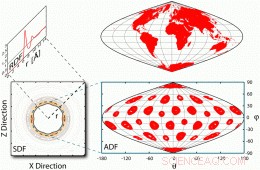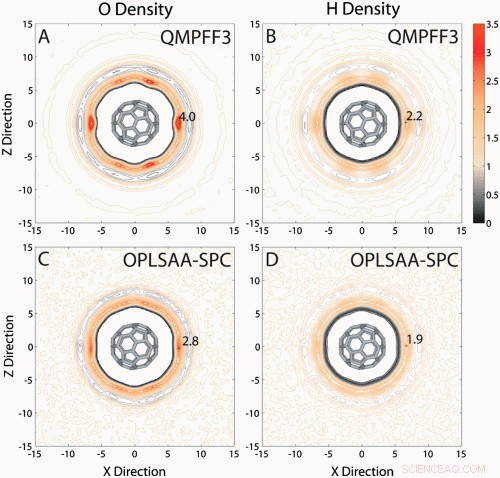
Diverse funzioni di distribuzione di una molecola d'acqua. Tre modi diversi per misurare l'ordine degli atomi di acqua O e H intorno a C60 o addirittura qualsiasi soluto. La più ovvia è la funzione di distribuzione spaziale tridimensionale (SDF) che mostra la densità in corrispondenza di ciascun elemento di volume centrato in ogni punto dello spazio definito dalle coordinate (x, si, z). Soffre delle gravi difficoltà associate alla visualizzazione e all'analisi di una mappa tridimensionale generale. La più comunemente usata è la funzione di distribuzione radiale unidimensionale (RDF) che calcola la media del numero di atomi di O o H su tutti gli elementi di volume a una distanza r dal centro di C60, dove r2 Ľ x2 þ y2 þ z2. Sebbene tale media aumenti il rapporto segnale-rumore, l'RDF nasconde molte caratteristiche della mappa tridimensionale della densità. Di fronte a queste limitazioni, introduciamo la funzione di distribuzione azimutale (ADF) che calcola mappe di densità in gusci sferici sottili ad un particolare valore di r in termini di coordinate polari sferiche (r, , ). I risultati, che presentano tutte le caratteristiche tridimensionali salienti di C60, sono facilmente visibili su carta utilizzando la proiezione di Sanson-Flamsteed (69) utilizzata dai primi cartografi. © PNAS, doi:10.1073/pnas.1110626108
(PhysOrg.com) -- L'acqua è essenziale per più dei suoi innumerevoli ruoli in ambito biologico, chimico, geologico, e altri processi fisici. Avere una descrizione precisa dell'acqua struttura è fondamentale per costruire simulazioni accurate di eventi molecolari, compreso il ripiegamento delle proteine, legame del substrato, riconoscimento macromolecolare, e formazione complessa. Un importante passo avanti nella creazione di tale descrizione è stato dimostrato presso la Stanford University School of Medicine, dove i ricercatori hanno scoperto che la polarizzazione aumenta la struttura ordinata dell'acqua. I loro risultati avranno un impatto significativo sui processi biologici.
Il Dr. Gaurav Chopra e il Professor Michael Levitt del Dipartimento di Biologia Strutturale hanno utilizzato simulazioni di dinamica molecolare che coinvolgono un campo di forza polarizzabile meccanico quantistico all'avanguardia (QMPFF3) per studiare l'idratazione del buckminsterfullerene, la più piccola nanosfera idrofoba ampiamente indicata come buckyball o C 60 . (Le molecole idrofobe come i fullereni sono respinte dall'acqua, e tendono ad essere sia apolari che elettricamente neutri.)
C'erano molte sfide da superare nella progettazione e implementazione di simulazioni di dinamica molecolare basate su QMPFF3, in particolare per studiare il comportamento delle molecole d'acqua accanto a superfici idrofobe con dettaglio atomico e risoluzione temporale subpicosecondo. “Il primo era la necessità di utilizzare un campo di forza polarizzabile adatto, ” spiega Chopra. “Ne esistono diversi – per esempio, AMEBA, versioni polarizzabili di OPLS, AMBRA, e CHARMM - ma tutti questi sono empirici essendo stati parametrizzati per adattarsi ai dati sperimentali come inizialmente esposto da Warshel e Lifson in un articolo del 1968 che discuteva la loro campo di forza consistente . Volevamo usare un campo di forza ab initio che sarebbe stato meno sensibile alla parametrizzazione arbitraria." Mentre un tale campo di forza era stato sviluppato da Algodign, LLC a Mosca, non era disponibile accademicamente. Però, visitando Algodign in Russia tre anni fa, e con l'intervento di Levitt, hanno ottenuto i diritti accademici.
“Abbiamo iniziato adattando il programma QMPFF3, AlgoMD, per lavorare sui core multipli del nostro supercomputer Linux (BioX 2 )” continua Chopra. “Quindi è stato necessario eseguire vari test per ottenere la corretta configurazione del protocollo di equilibrazione con il set corretto di parametri per il normale controllo della temperatura e della pressione insieme alla selezione del tipo di atomo più rilevante da utilizzare per il buckyball. La scelta del sistema di test ottimale è stata facile poiché il laboratorio Levitt aveva precedentemente lavorato su questa molecola con campi di forza empirici non polarizzabili.
La sfida finale era trovare un metodo per visualizzare la struttura dell'acqua intorno al buckyball. "Il metodo più popolare per studiare la struttura dell'acqua attorno a qualsiasi soluto utilizzava una funzione di distribuzione radiale unidimensionale che calcola la media del numero di atomi di acqua O e H a una particolare distanza per aumentare il rapporto segnale-rumore, ” spiega Chopra. “Questa funzione di distribuzione radiale unidimensionale nasconde molte caratteristiche della mappa della densità tridimensionale attorno a qualsiasi soluto di forma arbitraria. Di fronte a queste limitazioni e per tenere conto della simmetria del pallone da calcio di C 60 abbiamo introdotto il Funzione di distribuzione azimutale per visualizzare la densità O e H distribuita così com'è in gusci sferici concentrici.
Per affrontare queste sfide, il team dipendeva da una lunga storia di ricerche correlate. “Dal lavoro pionieristico sul campo di forza coerente sviluppato da Shneior Lifson più di 50 anni fa, il modello di un atomo è stato un nucleo con una carica parziale. Riteniamo che sia giunto il momento di passare a una rappresentazione più realistica di un atomo come un nucleo e una nuvola di elettroni di massa zero distribuita esponenzialmente attorno ad esso.” L'implementazione di questa rappresentazione in QMPFF3 ha permesso di modellare correttamente l'effetto della polarizzazione. We studied the structure of polarized water around polarized Buckminsterfullerene to show that polarization induces a strong hydrophobic effect; this has been under-represented by the limitations due to approximate modeling of atomic interactions in the empirical force fields widely used for the past decades.
The sensitivity of their novel method for detecting surface roughness shows that the hydrophobic effect is much stronger at short- and long-range for QMPFF3 compared to empirical force fields simulations. Per questa ragione, QMPFF3 is expected to have a profound effect in understanding key biological processes like protein folding. Using a novel and highly sensitive method to measure surface roughness and detect water ordering, we show that accurate modeling of solute and solvent polarization results in a stronger hydrophobic effect, Chopra summarizes.

SDFs (QMPFF3 vs. empirical force field). SDFs for water oxygen (O) and hydrogen (H) density around C60 for (A and B) QMPFF3 and (C and D) OPLS-AA with SPC water (OPLSAA-SPC). The orange contours represent higher O and H atom density, and black contours represent lower density than bulk. Both OPLSAA-SPC and QMPFF3 have an excluded volume around C60, a layer of low water density, and well-defined first and second water hydration shells. QMPFF3 water shells around C60 are more structured in radial and azimuthal direction with well-defined peaks; there is no structure apparent in the azimuthal direction for OPLSAA-SPC. The ratio of highest O to H density was 1.4 for OPLS-AA with SPC water and 1.8 for QMPFF3. © PNAS, doi:10.1073/pnas.1110626108
Apart from the azimuthal distribution functions developed to analyze the results, another challenge was to make suitable choices in the simulation protocol to significantly enhance the physical reality of the C 60 water system. The van der Waals equivalent for QMPFF3 is the combination of exchange and dispersion terms in QMPFF3. We used aromatic atom types for C 60 that were reparameterized by simple model correction using coupled-cluster with single and double and perturbative triple excitations data in QMPFF3. We also used long-range dispersion correction terms for total energy and pressure caused by truncation of dispersion forces. Chopra stresses that the study was computationally very intensive, and would not have been possible without the National Science Foundation-supplied BioX 2 supercomputer.
Chopra also points out that while QMPFF3 is one of the best polarizable force fields available today, as it is a general purpose ab initio force field which has been parameterized using only quantum mechanical data to successfully reproduce the experimental data for a large array of chemical compounds in all three phases of matter, it is not perfect. We can reparameterize certain special atom types using a higher level and more accurate quantum mechanical data as well as introduce new atom types for specific applications. The functional form may also need to be modified to further increase the physically realistic representation of the non-bonded parts of the force field currently modeled as dispersion, exchange, electrostatics and induction, he notes. These advances could significantly improve the performance of this state-of-the-art polarizable force field.
D'altra parte, Chopra points out, By adapting the QMPFF3 program on GPUs one could significantly increase its computational performance to study much larger systems of interest at biologically relevant timescales. Based on our tests, QMPFF3 is about 10 times slower than the empirical force field simulations to study protein-water systems on commodity clusters. We therefore think it is important to make advances to simultaneously improve the physical reality as well as increase the computational efficiency of the current state-of-the-art polarizable force field.
Chopra sees the teams findings as relevant to a wide range of possible applications. Our work is at the intersection of material science, nanotechnology and fundamental interactions in protein folding. The nature of the hydrophobic effect forms the basis of protein folding simulations and fullerenes are perfect model systems to study the affect of such interactions. Inoltre, polarization has always been neglected or modeled incorrectly but our results show the importance of polarization resulting in stronger short- and long-range hydrophobic interactions.
Chopra acknowledges that while their findings are not directly applicable to the development of fullerene-based biosensors as such, biosensors are made using water-soluble fullerene derivatives. Having discovered the correct way to include of polarization for your system of interest to make it physically realistic could significantly advance the selection of suitable groups to be attached to fullerenes for many applications, including biosensors, as well as for significantly advancing the process of drug discovery. Our result can be used as a quick way to include the effect of the arrangement of water molecules based on the surface topology of a hydrophobic binding pocket. Generalmente, the accurate treatment of polarization to include the affect of solvent in the binding pocket will potentially be useful for advancing computational drug design. Chopra is also very interested to study the effect of polarization on biological systems like proteins in non-homogenous solvent simulations.
Ours is a very general technique and any system can be studied with the simulation and analysis methods of this paper, Chopra concludes. Since QMPFF3 is a general-purpose polarizable force field and, for studying any system, it gives a physically realistic treatment to include polarization, which is essential for any biological system as they are always present in a polar medium like water. Anche, our method to study water structure is a significant advance over currently used techniques and should be used to visualize water structure around any arbitrary shaped solute.
Copyright 2011 PhysOrg.com.
Tutti i diritti riservati. Questo materiale non può essere pubblicato, trasmissione, riscritto o ridistribuito in tutto o in parte senza l'espresso permesso scritto di PhysOrg.com.